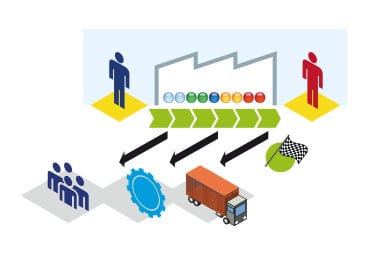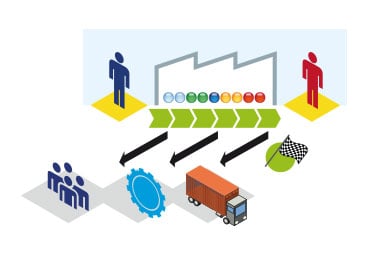How Will Industry 4.0 Change Your Production Network?
Brian Hoey - June 04, 2019

 In his seminal work of economic theory, “The Wealth of Nations,” Adam Smith famously uses a pin factory as his example to illustrate a number of basic concepts in what was then modern capitalism. Today, the production of something as simple as a pin can essentially be a global affair. In all likelihood, your production facility needs to receive shipments of raw material from elsewhere in the world via a complex set of routes and distribution points. The factory itself may be part of a larger, international organization with diffuse planning processes taking place in parallel all across the world. And the finished product, once it’s been produced, might be sent anywhere in the world—after all, people all of all nationalities and backgrounds sometimes need pins.
In his seminal work of economic theory, “The Wealth of Nations,” Adam Smith famously uses a pin factory as his example to illustrate a number of basic concepts in what was then modern capitalism. Today, the production of something as simple as a pin can essentially be a global affair. In all likelihood, your production facility needs to receive shipments of raw material from elsewhere in the world via a complex set of routes and distribution points. The factory itself may be part of a larger, international organization with diffuse planning processes taking place in parallel all across the world. And the finished product, once it’s been produced, might be sent anywhere in the world—after all, people all of all nationalities and backgrounds sometimes need pins.
Whether you produce pins or something more complicated (like automobiles, for instance), your business exists within a complex global production network. As such, any trends in manufacturing and logistics that emerge in the global economy will likely have some impact on your business, regardless of how directly it seems to affect you. Case in point, Industry 4.0 is quickly transforming the way that goods are both created and transported, empowering smart, digital processes that would have been virtually impossible in earlier eras. The question you might be asking yourself now is, “what impact will Industry 4.0 have for my company and my planning workflows?”
Understanding Your Production Network
In recent years, the idea of the “Global Production Network” has become popular as an alternative to (or, really, an expansion of) the idea of the value chain. Firstly, it works as a reminder that the production of goods as a process doesn’t really stop at the edge of the factory floor, and that, in fact, it’s frequently a process that begins and ends outside the boundaries of a given assembly line. As Industry 4.0 workflows are becoming more common, this is becoming increasingly true. Think about it: if your factory or a nearby partner has an additive manufacturing (i.e. 3D printing) setup, you might find that a particular component part in your larger product could be easily printed, saving you time and resources within your own physical operations while expanding the boundaries of your production flows. This would change not just the particulars of your production flow, but the nature of it, in ways that would have to be reckoned with.
As you can imagine, this understanding of production can get complicated pretty quickly. For this reason, in order to gain a deeper understanding of how future trends like the fourth industrial revolution will impact your operations, you first need to come to a more complete understanding of your existing production network. Ask yourself: what does the process of creating value look like within your organization? How do your production plans directly and indirectly interact with processes outside of the factory? This will include traditional supply chain elements like raw material sourcing, yes, but it might also include value additive logistics processes (production-in-truck workflows for furniture manufacturers are just one example) or even more diffuse processes in which multiple factories combine to create one product. For instance, you might be producing engine blocks in a separate location and transporting them to the area where completed automobiles are actually assembled.
The Global Factory
Hopefully, as you map out the elements of your production network, you’ll begin to see potential hidden connections and new synergies lurking beneath the surface. In our engine block example, for instance, closer examination might uncover untapped efficiencies in the sourcing of raw materials. If there are overlapping material needs across these two production facilities, you may be able to gain a discount by combining two separate orders into one bulk order that you can distribute between locations yourself. On the other hand, you might find that one production line in particular is underusing its capacity, meaning that there’s the potential for more optimal usage.
As more and more of your options become clear to you, the implications of the Industry 4.0 era become increasingly relevant. To wit, Industry 4.0’s unique mix of connected, data-driven workflows and cyber-physical systems is currently empower the “Global Factory,” in which diffuse decision-making and production processes make it possible to more efficiently utilize global manufacturing resources. Rather than being beholden to their own physical spaces, modern, digitized manufacturers are able to gain clear insights into one another’s capacity and arrange for parts and products to be conceived in one place, produced in another, and assembled somewhere else entirely. This type of flexibility (and the optimization potential that comes with it) requires a high degree of visibility and insight into your processes, to say nothing of substantial IT integration with suppliers and partners, but for a planner who thoroughly understands her production network it can lead to significant time and money saved.
Advanced Planning and Scheduling
Now, as we’ve discussed the way that modern production networks operate, you may have been envisioning a planner using pen and paper or spreadsheet to audit existing processes and develop a more robust understanding of how value is added in the creation and distribution of goods. But in the Industry 4.0 era, this might not be the ideal picture. Rather than relying on the manual efforts of human planners, smart production networks will use IoT (internet of things) devices and other digital elements to automate data collection and empower digital representations of your supply and production chains—potentially including real-time data to give planners a complete, up-to-the-minute overview of what’s going on within their operations. In this way, they can make small adjustments to ongoing plans as needed.
This all brings us back to the important question: how will Industry 4.0 affect your production network? As we’ve seen above, Industry 4.0 technologies can give planners a new view of value creation and production planning—one that encompasses a diffuse, global value stream that can be leveraged in creative, intelligent ways. This will have significant ramifications for advanced planning and scheduling in particular. Why? Because the allocation of production capacity is being revolutionized by the types of changes we described above. Going forward, rather than being hemmed in by the restrictions of your existing network, you’ll be able to take advantage of new, emerging networks that challenge the boundaries of the traditional factory. If you’re in a position to take advantage of these new paradigms, you stand to reduce costs through increased sourcing and production efficiency.
LATEST POSTS
- Understand Circular Economy in The Manufacturing Industry
- How Can Industry 4.0 IT Integration Be Achieved Smoothly?
- The Significance of Order Sequencing in Discrete Manufacturing
- How to improve your Supply Chain Management: The Power of Control Towers
- Optimizing Human Resource Scheduling in Manufacturing: A Technological Approach



